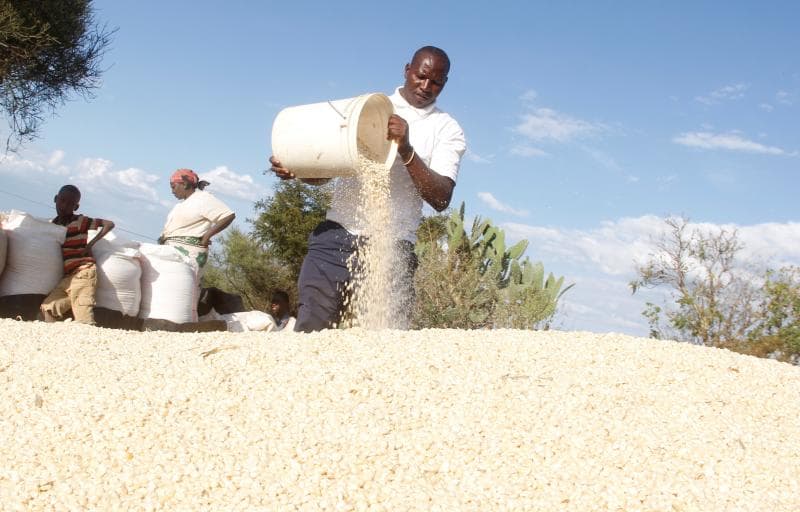Loading News Article...
We're loading the full news article for you. This includes the article content, images, author information, and related articles.
We're loading the full news article for you. This includes the article content, images, author information, and related articles.
A projected record harvest in Kenya's grain basket has ignited fierce competition between the NCPB and private traders, pushing maize prices to new highs and raising questions about the impact on national food security and consumer costs.

A surge in maize production in Kenya's North Rift region has triggered an intense scramble for the staple grain, pitting the National Cereals and Produce Board (NCPB) against a wave of private traders from across the country. This fierce competition has driven farm-gate prices to a profitable Sh3,250 per 90kg bag, a welcome development for farmers but a looming concern for consumers who may face higher flour prices.
The heightened market activity comes as Kenya anticipates a historic maize harvest of 70 million bags this season, a significant increase from 67 million bags in the previous season and 44 million in 2022. This bumper crop is largely attributed to the government's fertiliser subsidy program, which President William Ruto stated has distributed over 21 million bags of affordable fertiliser, saving farmers more than Sh105 billion in production costs. In his State of the Nation Address, the President noted that 7 million bags of fertilizer and 35 million kilos of certified seed were delivered this year alone.
The NCPB is aiming to purchase up to 2 million bags for the National Strategic Food Reserve, offering farmers Sh3,500 per 90kg bag. However, private millers and traders, some reportedly coming from as far as Nairobi and Kitui, have entered the market aggressively, with some offering as high as Sh3,600 per bag to secure their stocks. This price war has created a lucrative environment for farmers, but it has also led to a slow delivery rate to NCPB depots. According to NCPB Corporate Communications Manager Titus Maiyo, the board had purchased about 100,000 50kg bags as of late November 2025, with deliveries described as "slow but steady".
The influx of traders has been a double-edged sword. While farmers are enjoying better returns, there are growing concerns about the potential for exploitation. Uasin Gishu Governor Jonathan Bii has cautioned farmers against selling their maize on credit to prevent losses from unscrupulous traders who might disappear without making payments. Millers, on the other hand, are urging the government to harmonize cess and levies across counties to ensure a smoother flow of maize from the farms to the mills.
The record harvest is a significant step towards national food security. Agriculture Cabinet Secretary Mutahi Kagwe has termed the harvest “historic,” noting that it could lead to the government restocking the National Strategic Food Reserve and stabilizing staple food prices. Deputy President Kithure Kindiki announced in February 2025 that due to the impressive local production, Kenya would not need to import maize for the first time in 16 years. Kenya's annual maize requirement stands at 52 million bags, covering human consumption, livestock feed, and other uses.
The economic impact of the bumper harvest is expected to be widespread. Increased farmer incomes are anticipated to boost rural economies, creating employment in transportation, storage, and marketing. Furthermore, a surplus could open up trade opportunities within the East African region, positioning Kenya as a key supplier to food-insecure areas. However, challenges in regional trade persist, with non-tariff barriers and inconsistent policies sometimes hindering the cross-border movement of grain.
Despite the positive outlook, farmers in the North Rift continue to face challenges. The high cost of production remains a significant concern, with some farmers stating it costs over Sh2,500 to produce a single 90kg bag. There are also calls for the government to improve infrastructure, such as functional dryers and storage facilities at NCPB depots, to reduce post-harvest losses, a problem that has plagued farmers in the past. Some farmers have expressed dissatisfaction with the government's buying price, arguing that it does not adequately cover the rising costs of inputs and labor.
As traders continue to flock to the North Rift, the market dynamics will be closely watched. The competition for maize will likely keep prices favorable for farmers in the short term, but the long-term impact on consumer prices and the national strategic reserve remains a critical issue for policymakers. The successful management of this maize boom will be crucial in ensuring that the benefits are felt across the entire value chain, from the farmer to the consumer, securing Kenya's food basket for the year ahead.
Keep the conversation in one place—threads here stay linked to the story and in the forums.
Other hot threads
E-sports and Gaming Community in Kenya
Active 6 months ago
Popular Recreational Activities Across Counties
Active 6 months ago
Investing in Youth Sports Development Programs
Active 6 months ago
The Role of Technology in Modern Agriculture (AgriTech)
Active 6 months ago